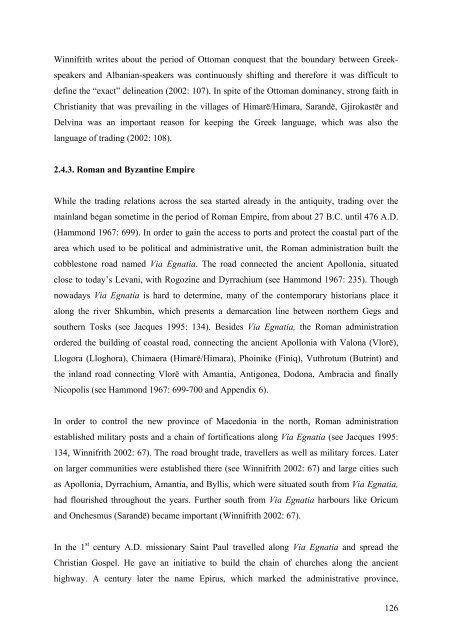university of nova gorica graduate school contested spaces and ...
university of nova gorica graduate school contested spaces and ...
university of nova gorica graduate school contested spaces and ...
You also want an ePaper? Increase the reach of your titles
YUMPU automatically turns print PDFs into web optimized ePapers that Google loves.
Winnifrith writes about the period <strong>of</strong> Ottoman conquest that the boundary between Greekspeakers<br />
<strong>and</strong> Albanian-speakers was continuously shifting <strong>and</strong> therefore it was difficult to<br />
define the “exact” delineation (2002: 107). In spite <strong>of</strong> the Ottoman dominancy, strong faith in<br />
Christianity that was prevailing in the villages <strong>of</strong> Himarë/Himara, Sar<strong>and</strong>ë, Gjirokastër <strong>and</strong><br />
Delvina was an important reason for keeping the Greek language, which was also the<br />
language <strong>of</strong> trading (2002: 108).<br />
2.4.3. Roman <strong>and</strong> Byzantine Empire<br />
While the trading relations across the sea started already in the antiquity, trading over the<br />
mainl<strong>and</strong> began sometime in the period <strong>of</strong> Roman Empire, from about 27 B.C. until 476 A.D.<br />
(Hammond 1967: 699). In order to gain the access to ports <strong>and</strong> protect the coastal part <strong>of</strong> the<br />
area which used to be political <strong>and</strong> administrative unit, the Roman administration built the<br />
cobblestone road named Via Egnatia. The road connected the ancient Apollonia, situated<br />
close to today’s Levani, with Rogozine <strong>and</strong> Dyrrachium (see Hammond 1967: 235). Though<br />
nowadays Via Egnatia is hard to determine, many <strong>of</strong> the contemporary historians place it<br />
along the river Shkumbin, which presents a demarcation line between northern Gegs <strong>and</strong><br />
southern Tosks (see Jacques 1995: 134). Besides Via Egnatia, the Roman administration<br />
ordered the building <strong>of</strong> coastal road, connecting the ancient Apollonia with Valona (Vlorë),<br />
Llogora (Lloghora), Chimaera (Himarë/Himara), Phoinike (Finiq), Vuthrotum (Butrint) <strong>and</strong><br />
the inl<strong>and</strong> road connecting Vlorë with Amantia, Antigonea, Dodona, Ambracia <strong>and</strong> finally<br />
Nicopolis (see Hammond 1967: 699-700 <strong>and</strong> Appendix 6).<br />
In order to control the new province <strong>of</strong> Macedonia in the north, Roman administration<br />
established military posts <strong>and</strong> a chain <strong>of</strong> fortifications along Via Egnatia (see Jacques 1995:<br />
134, Winnifrith 2002: 67). The road brought trade, travellers as well as military forces. Later<br />
on larger communities were established there (see Winnifrith 2002: 67) <strong>and</strong> large cities such<br />
as Apollonia, Dyrrachium, Amantia, <strong>and</strong> Byllis, which were situated south from Via Egnatia,<br />
had flourished throughout the years. Further south from Via Egnatia harbours like Oricum<br />
<strong>and</strong> Onchesmus (Sar<strong>and</strong>ë) became important (Winnifrith 2002: 67).<br />
In the 1 st century A.D. missionary Saint Paul travelled along Via Egnatia <strong>and</strong> spread the<br />
Christian Gospel. He gave an initiative to build the chain <strong>of</strong> churches along the ancient<br />
highway. A century later the name Epirus, which marked the administrative province,<br />
126

















